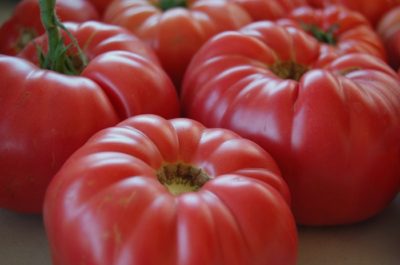|
Listen To The Article
|

Your best crop of tomatoes yet!
Now that your vegetable garden is planted and off to a good start, you need to stay vigilant if you want to have a productive crop this summer. Here are some steps you can take to get the most out of your garden this year.
Tomatoes
Your tomato plants need frequent and deep watering. Add a thick layer of mulch around the base of the plants to help conserve moisture and to help regulate soil temperature. When you see the fruit beginning to form, work some additional all-natural fertilizer into the soil around the base of your plants.
Because tomato plants are basically vines, they require support. Purchase tomato tripods from your nursery or make your own out of wire or bamboo stakes. Make sure the supports are strong enough and provide enough tension to support the growing plants.
You will be able to pull a ripe tomato easily from its vine. Take hold of the fruit, gently twisting to remove it and taking care not to break the main stem.
Carrots
Consider lightweight row covers for your carrot seedlings to help them retain moisture while allowing sunlight to pass through. When you notice your seedlings beginning to sprout, remove the covers. Carrots do not grow well when they are too close together. After the young plants reach two inches in height, thin them to one plant every four to six inches or so by gently snipping the foliage at ground level. Pulling them up can disturb the plants you want to keep.
All Natural Fertilizer Doubles Garden Production!
Carrots like damp soil and need about one inch of water each week. A generous layer of mulch around the base of the plants will help them stay moist and help prevent weeds. Protect your growing carrots by mounding soil over them. You can also make a liquid fertilizer by mixing one tablespoon of fish emulsion with one gallon of water.
Most carrots are ready for harvest 60 to 80 days after sowing. Check the carrot’s color; usually the brighter, the better. To harvest, loosen the soil around the root with a small spade before pulling it up by its greens. You can harvest carrots as needed, since they will be fine in the ground for weeks.
Beans
When your bean seedlings sprout, thin them to one plant every six to eight inches for optimum growth. As with your other plants, add a layer of mulch to retain moisture and to prevent weeds. Water your bean plants early in the morning so that the foliage has plenty of daylight time to dry. Don’t harvest or work around your bean plants when they are wet, since disease can spread more quickly when the plants are damp.
Apply an organic fertilizer every two weeks for the first six weeks, then about once every four weeks after that. If you notice bean beetles, you can pick them off by hand and dispose of them.
Since beans are vining plants that need to climb, be sure to offer them poles or other tall objects to wrap around as they grow. Bush beans are ready to harvest in 50 to 60 days, and pole beans are ready in 60 to 90 days. Harvest beans when the pods are four to six inches long. For best flavor, harvest beans frequently. Frequent harvesting also encourages continued production. Gently pull the pods from the vine, taking care to avoid knocking the blooms off the plant.
Amazing Sea Minerals Help Grow More Nutritionally Dense Foods.
Cucumbers
After your cucumber plants germinate, add a generous layer of mulch to conserve moisture. Be careful to avoid the stems of the plants, however, or they might rot. Feed your cucumber plants every two weeks with liquid fertilizer and keep the soil moist throughout the growing season.
To protect your plants from bugs and beetles, cover the plants with floating row covers until they start blooming. If you notice cucumber beetles, you can hand pick them off.
Cucumbers grow fast — seemingly overnight – so keep a close eye on them. Harvest them when they are still dark green by holding the fruit in one hand and snipping the vine about a half-inch above the fruit.
Bell Peppers
Give your peppers about an inch of water every week and fertilize them when the plants reach about half their full size, and again when they begin displaying fruit. Once again, mulch will help with retaining moisture and with limiting weed growth.
You can harvest and eat peppers at just about any stage, but most gardeners wait until they are fully grown and their color is fully developed. You can pull a ripe pepper easily from the plant, but use pruners to remove fruit at an earlier time to avoid damage.
Onions
Onion seedlings need daily watering until they get established. A thick layer of mulch will help keep the ground moist.
Onions develop in two steps. During the first stage, the top leaves fill out, and then the plant uses the energy from those leaves to nourish the bulb. You can pull and eat green onions at almost any stage. Larger onions are ready when their tops begin to bend over. Use your hands to harvest onions, garlic and shallots so that you don’t damage the tender bulbs. Let the newly harvested onions set outside in a dry, shady place before bringing them inside.
Potatoes
You will need to “hill” your potatoes – or pile soil around the stems — about five weeks after planting or when your plants reach eight to 10 inches in height. By bringing soil up around the vines on all sides, you force new potatoes to grow above the seed potatoes you planted earlier.
Potatoes usually mature in about 70 to 100 days. When potatoes are about ready to harvest, their leaves will yellow and their foliage will begin to droop. Leave them in the ground for several weeks so that their skins will toughen. Then carefully dig them up using a pitch fork and your hands. Wash and eat or store for later use in a dry, cool spot.
No matter what you are growing this summer be diligent in watering, mulching, weeding and harvesting for best results. When you pick your produce as soon as it is ready, you allow the plant’s energy to go into growing and supporting more fruit.
What tips would you add to the list? Let us know in the comments section below.
 Off The Grid News Better Ideas For Off The Grid Living
Off The Grid News Better Ideas For Off The Grid Living



